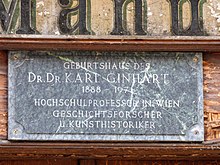Karl Ginhart
Karl Ginhart (born November 21, 1888 in St. Veit an der Glan , † March 10, 1971 in Vienna ) was an Austrian art historian .
Life
A native of Carinthia Karl Ginhart devoted himself to filed Matura studies of law and art history at the Universities of Vienna , Berlin and Innsbruck , in 1912 he became the Dr. iur. , 1919 at the University of Vienna with Josef Strzygowski as Dr. phil. PhD . Ginhart subsequently held an assistant position at the I. Art History Institute of the University of Vienna until he took up the post of state curator of the Federal Monuments Office in 1926 , an office he held until 1936. In 1930 he was appointed director of the Art History Institute of the Federal Monuments Office, and in 1939 he resigned from this position.
Ginhart completed his habilitation at the University of Vienna around 1930 . In 1936 he was appointed associate professor and in 1942 full professor at the Vienna University of Technology and held these positions with one interruption after 1945 until his retirement in 1960. In addition, between 1941 and 1943 he gave the course "Art and History as a Factor in Tourism" at the Vienna University of World Trade - each summer semester.
Ginhart was a member of the NSDAP from 1930 to 1932 and was reinstated in 1941 after a re-entry application that he submitted in 1938. As a memo from the Vienna Gauleitung dated July 8, 1938, the plan was to have Ginhart collect and inspect all of the furnishings that were in the apartments of refugee Jews but were not confiscated. Ginhart was part of the personal entourage of the Carinthian Gauleiter Franz Kutschera and Friedrich Rainer . In 1937 he gave a lecture entitled “Relations between Race and Art in Spain” for the Vienna Society for Race Care.
On the occasion of his retirement in 1960, Ginhart received the Austrian Cross of Honor for Science and Art . He carried out essential preparatory work for the Dehio Carinthia monuments directory , which, however, only appeared after his death.
Publications
- The Christian capital between antiquity and late Gothic . Art History Institute of the University, Vienna 1923 (dissertation)
- The Imperial Crypt at the PP. Capuchins in Vienna . Logos Verlag, Vienna 1925
- with Bruno Grimschitz : The Gurk Cathedral . Krystallverlag, Vienna 1930
- with Alfred Karasek : Directory of the writings of Josef Strzygowski . Kollitsch, Klagenfurt 1933
- with Georg Dehio : The art monuments in Carinthia, Salzburg, Styria, Tyrol and Vorarlberg . Anton Schroll, Vienna 1933
- The art monuments of Carinthia . Klagenfurt 1934
- Georg Khevenhüller Metsch: The Hochosterwitz in Carinthia . Kollitsch, Klagenfurt 1939
- The St. Paul Abbey in Lavanttal . Self-published by the pen, 1953
- The early medieval Martinskirche on the Römerberg in Linz . City Museum, Linz 1968
- The princely statues of St. Stephan in Vienna and the sculptures from Grosslobming. With a life report of the author . History Association for Carinthia, Klagenfurt 1972
literature
- Walther Killy , Rudolf Vierhaus (ed.): German Biographical Encyclopedia . Volume 4, KG Saur Verlag GmbH & Co. KG, Munich, 1996 ISBN 3-598-23163-6 , p. 11.
Individual evidence
- ↑ Vienna University of Economics and Business: Lecture directories for the University of World Trade. Retrieved July 7, 2020 .
- ↑ Susanne Heim: The persecution and murder of European Jews by National Socialist Germany 1933–1945, Volume 2: German Reich 1938 - August 1939. Oldenbourg Wissenschaftsverlag, 2009 p. 213 .
- ↑ Susanne Heim: The persecution and murder of European Jews by National Socialist Germany 1933–1945, Volume 2: German Reich 1938 - August 1939. Oldenbourg Wissenschaftsverlag, 2009 p. 212 .
- ↑ Husslein-Arco, Agnes & Böckl, Matthias: Eremiten-Kosmopoliten. Modern painting in Carinthia 1900-1955 . Vienna / New York: Springer 2004. p. 320.
- ↑ Exner, Gudrun: "Eugenics in Austria until 1938". In: Mackensen, Rainer (Ed.): Population doctrine and population policy in the “Third Reich” . Opladen: Leske + Budrich 2004. p. 354.
- ↑ Wiener speech leaves , Volume 10/1960, No. 5, pp 93rd
Web links
- Literature by and about Karl Ginhart in the catalog of the German National Library
- Entry on Karl Ginhart in the Austria Forum (in the AEIOU Austria Lexicon )
| personal data | |
|---|---|
| SURNAME | Ginhart, Karl |
| BRIEF DESCRIPTION | Austrian art historian |
| DATE OF BIRTH | November 21, 1888 |
| PLACE OF BIRTH | St. Veit an der Glan |
| DATE OF DEATH | March 10, 1971 |
| Place of death | Vienna |
